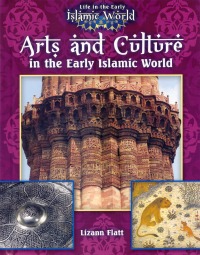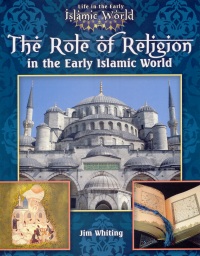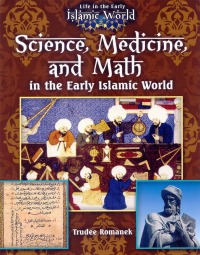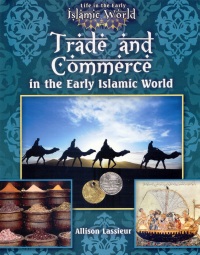| ________________
CM . . .
. Volume XVIII Number 36. . . .May 18, 2012

 |
Arts and Culture in the Early Islamic World. (Life in the Early Islamic World).
Lizann Flatt.
St. Catharines, ON: Crabtree, 2012.
48 pp., pbk. & hc., $11.95 (pbk.), $21.56 (RLB.).
ISBN 978-0-7787-2174-1 (pbk.), ISBN 978-0-7787-2167-3 (RLB).
Subject Heading:
Islamic art-History-Juvenile literature.
Grades 5-8 / Ages 10-14.
Review by Harriet Zaidman.
**** /4
|
| |
|
 |
The Role of Religion in the Early Islamic World. (Life in the Early Islamic World).
Jim Whiting.
St. Catharines, ON: Crabtree, 2012.
48 pp., pbk. & hc., $11.95 (pbk.), $21.56 (RLB.).
ISBN 978-0-7787-2176-5 (pbk.), ISBN 978-0-7787-2169-7 (RLB).
Subject Headings:
Islam-History-Juvenile literature.
Islamic Empire-History-Juvenile literature.
Grades 5-8 / Ages 10-14.
Review by Harriet Zaidman.
**** /4
|
| |
|
 |
Science, Medicine and Math in the Early Islamic World. (Life in the Early Islamic World).
Trudee Romanek.
St. Catharines, ON: Crabtree, 2012.
48 pp., pbk. & hc., $11.95 (pbk.), $21.56 (RLB.).
ISBN 978-0-7787-2177-2 (pbk.), ISBN 978-0-7787-2170-3 (RLB).
Subject Headings:
Science-Islamic Empire-History-Juvenile literature.
Medicine-Islamic Empire-History-Juvenile literature.
Mathematics-Islamic Empire-History-Juvenile literature.
Grades 5-8 / Ages 10-14.
Review by Harriet Zaidman.
**** /4
|
| |
|
 |
Trade and Commerce in the Early Islamic World. (Life in the Early Islamic World).
Allison Lassieur.
St. Catharines, ON: Crabtree, 2012.
48 pp., pbk. & hc., $11.95 (pbk.), $21.56 (RLB.).
ISBN 978-0-7787-2179-6 (pbk.), ISBN 978-0-7787-2172-7 (RLB).
Subject Headings:
Islamic Empire-Commerce-Juvenile literature.
Islamic Empire-Economic conditions-Juvenile literature.
Grades 5-8 / Ages 10-14.
Review by Harriet Zaidman.
**** /4
|
| |
|

excerpt:
Before the rise of Islam, the Arab peoples were primarily nomads, living in small tribes. The tribes had different religions and ways of life. Each tribe traded with its friends and raided its enemies. Traders traveled across the desert together in small caravans, or groups of people, stopping wherever there was water….
Muhammad and the religion of Islam united the tribes. After Muhammad’s death in 632, Muslims moved far across the Middle East and North Africa. As the Islamic state expanded, Muslims found vast new areas for trade and commerce. Stability created enormous wealth for the new Muslim society, and the Islamic world began its Golden Age. (From Trade and Commerce in the Early Islamic World.)
World events, including 9/11 and the subsequent wars in Afghanistan and Iraq, the 'Arab Spring', and other disruptions, have caused millions of people, primarily from Muslim countries to leave their homes, either as refugees or immigrants to other parts of Africa and Asia, Europe and North America. Societies drawn mainly from European and Judeo-Christian ideas are experiencing changes in their demographics, changes which have prompted an increasing interest in Muslim history, culture and beliefs.
The titles reviewed here (the series, published by Crabtree, has a total of six volumes), provide thorough explanations about the historical basis for the religious beliefs of Muslims and for how their society developed in the areas of trade, science, medicine and math and in arts and culture. The explanations are clear and link one topic to another as well as show how the histories of Europe and Asia were intertwined with Muslim societies and how each influenced the other. The books are interestingly designed, with antique colours, historical art, borders, print stylized to mimic Arabic script, pictures and more. Sidebars to the text add further information about each subject. Biographies of important personalities who were important in each of the fields (math, art, religion, etc.) round out each title. Appropriate words appear in bold type and are defined in a glossary at the back of the 48-page books, followed by a list of suggested books for future reading, websites and an index.
The texts detail how both trade and war contributed to the spread of Islam, how religious principles governed how trade and life are conducted, how these principles also guided adherents' decisions about the types of art and culture to pursue as well as which type of science to foster. Young people will be enlightened to learn that the number symbols 1-9 come from Hindu and Islamic numerals, that Muslim mathematicians developed algebra and algorithms and other advances in math that are universally applied today. They will learn that:
Until the 1000s, Muslim scientists treated astrology and astronomy as one subject. Then they decided that astrology had too much do to with "ungodly forces." Treating astronomy as a science added much to knowledge of the stars and planets. (From Science, Medicine, and Math in the Early Islamic World.)
The contributions of Islamic scholars to chemistry, medicine, mechanical inventions, navigation, etc. make fascinating reading, as well as useful research information. Slavery was a pillar of the Muslim economy and young adolescents will become informed about the accepted trade in human beings.
Students will learn that Muslims are not a monolithic group. There are several branches of Islam that developed after Muhammad's death when his followers and scholars interpreted his teachings in different ways, differences that still exist. The Role of Religion in the Early Islamic World explains the five basic beliefs of Islam, the meaning of a pilgrimage to Mecca and the changes to Islamic thought that took place as the Ottoman Empire weakened in the last 19th century.
One topic not discussed is the role of women in Islam. This is a subject of interest and concern to Westerners, especially women, who fought to attain rights and equality for women for more than 100 years, but see women in some Muslim societies subjugated to their fathers and husbands.
The "Life in the Early Islamic World" series will interest young readers and will be a welcome and useful addition to a school or public library collection.
Highly Recommended.
Harriet Zaidman is a teacher-librarian in Winnipeg, MB.

To comment
on this title or this review, send mail to cm@umanitoba.ca.
Copyright © the Manitoba Library Association. Reproduction for personal
use is permitted only if this copyright notice is maintained. Any
other reproduction is prohibited without permission.
NEXT REVIEW | TABLE OF CONTENTS FOR THIS ISSUE
- May 18, 2012.
AUTHORS | TITLES | MEDIA REVIEWS | PROFILES | BACK ISSUES | SEARCH | CMARCHIVE | HOME
|



